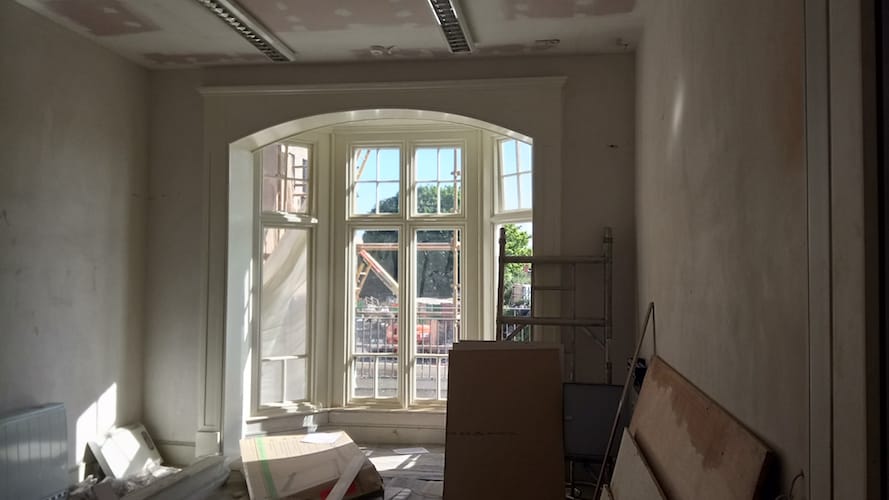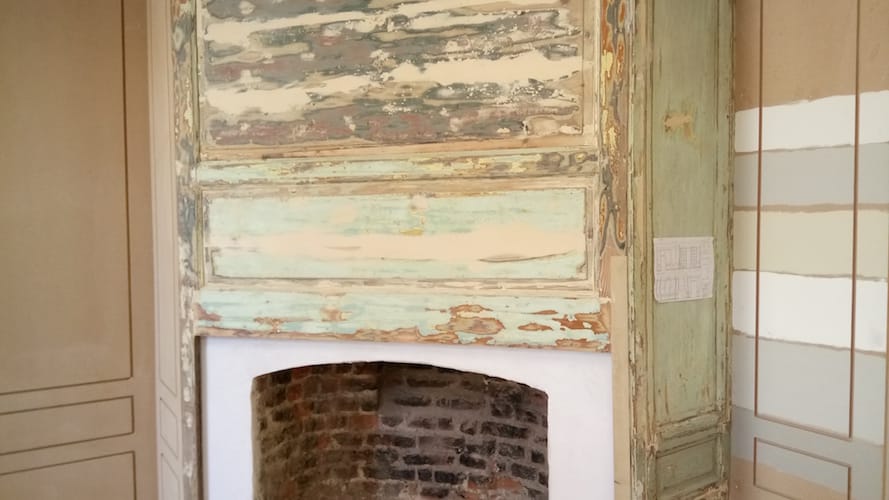What’s the best way to tell area residents about plans for a new asylum shelter nearby?
The government should tell communities directly about plans for new asylum shelters, some activists and politicians say.
As part of a development including student accommodation, the building is being restored and turned into offices for nearby Teeling Whiskey.

John Beattie may have intervened just in time to save an 18th-century house described as “one of the most significant historic buildings in the Liberties”.
Number 10 Mill Street was built by the earl of Meath in the 1720s. Then, with the adjoining Mission Hall, it became part of the 19th-century battle for souls, in which Protestants and Catholics competed to win converts by offering food, shelter, and free education to the poor.
When Beattie started to conserve the house as part of a project focused on building student accommodation on the site it was on the verge of collapse, he says. Now, though, he’s brought it back from the brink, and it’ll soon begin a new life, with a new purpose.
Before the restoration, the brickwork had been encased in cement, which doesn’t breathe, and so water was getting trapped behind the cement and eroding the brick. “It really was a race against time. It was eating itself from the outside in,” he says.
The site on which the house is built illuminates the industrial heritage of the Liberties, which dates back to a 13th-century mill, to which the monks diverted the River Poddle.
The area is known as the Blackpitts because of a large tanning industry, artefacts from which have been recovered from the site now being developed for student housing, just around the corner from Newmarket Square, and the Teeling Distillery.
Built by the Brabazon family in the 1720s, 10 Mill Street is often referred to as the Earl’s House. “It was a fantastic building, and had lovely panelled interiors and a fantastic staircase,” says Beattie.
It was a “double Dutch Billy“, he says, a style that can often be seen in Amsterdam today. This means it had two curved linear gables on the front, diagonal chimney breasts, and a cruciform roof, he says.
The Christian Brothers established a school on the site in 1819, and may have used the house as a residence.

By 1852 the school and house were owned by an Anglican Mission, the Irish Church Missions. They built the Mission Hall to the east in the 1890s.
Shortly thereafter, the house was significantly remodelled, and Beattie thinks this was done to match the style of the Mission Hall.
“Within ten years, number ten was transformed from its earlier Georgian appearance into a more Gothic appearance that you see today,” says Beattie.
Some of the original building has been preserved too. “If you look, you can clearly see the difference between the original brick and the Victorian brick,” he says.
The Rev Alexander Dallas founded the Irish Church Missions in 1847.
The Mission Hall in Mill Street would have been a local base for their social outreach and religious activities, says Colin Barr, senior lecturer in history at the University of Aberdeen.
They were one of several Protestant missions, based in England, that set out to convert Irish Catholics, he says.
They started out in the West of Ireland during the Famine. However, that mission was largely unsuccessful, in part due to the isolation and ostracisation faced by rural converts, says Barr.
Dublin had a large working-class Protestant population already, so it was possible to integrate people into a wider social network.
“So, the Protestant proselytising groups suddenly come into Dublin, because they failed in the West,” he says.
At the time, the state was providing very little in terms of social services, and the workhouse was regarded as the end of the road, he says.
So the Protestant missions stepped in, and in an effort to win converts, started offering supports, “whether it is food, whether it is shelter, clothing, medical or whatever it may be. Looking after orphans is a big one,” says Barr.
“You hope people will be drawn to your religious message through your social outreach,” he says.
The Catholic Church must have feared the move would work, because it quickly started to offer “competing social supports, such as charities and hospitals”, says Barr.
That’s how Catholic ownership of hospitals in Ireland arose in the 1850s, rather than after independence, as some might think, he says.
“Independent Ireland’s modern social provision, all these church schools, church hospitals and church orphanages, essentially dates back to a reaction by the church to the Protestant proselytising missions,” he says.
There were some conversions, but not a massive number, he says. But the reaction of the Catholic Church shows it feared that it would work. He says both sides believed the souls of the poor were up for sale.
“Both groups are sincere Christians who believe that they should look after the poor,” says Barr, using the present tense but referring the past. “That said, neither side actually does much, until there is a rivalry.”

The Site
The industrial heritage of the site dates all the way back to the original double mill of the 13th century, owned by the monks of Thomas’s Abbey.
They diverted the River Poddle to the mills, and the water power it provided was used for milling right up to the mid-20th century.
When Henry VIII dissolved the monasteries, in the 17th century, the site was granted to William Brabazon, an ancestor of the earls of Meath, according to information in the planning application for the current project.
Excavation of the site uncovered “a very impressive industrial landscape”, says archaeologist Claire Walshe, of Archaeological Projects Ltd.
This included the mill itself from the 18th century, several very large tanneries, and some ornate leatherwork.
The large tannery was a significant find. “It’s another aspect of the industrial heritage of the area, and it is where the name Blackpitts came from. It is nothing to do with the plague,” Walshe says.
Most of the finds date from the early 18th century, “which was the height of an industrial boom”, says Walshe. (By the late 18th century, protectionism in Britain had damaged Irish industry, she says, and that is when the Liberties began to fall into decline.)
Walshe also discovered another 17th-century house, which was made of stone, and was much smaller than 10 Mill Street, she says.
There was also a “ragged school” on the site, she says, which changed hands among different religious groups over the decades.
Walsh and her colleagues found beautiful leatherwork there, including a leather book cover, which she says is “a very significant find”.
They are going to feature some of the artefacts recovered within the landscaped gardens of the new student accommodation, says Beattie, the conservation consultant.
“Granite stones will be used as seating, parts of the mill will be placed in soft landscaping … it will really enliven the student accommodation,” he says.
The site is also one of the few places in the city where it is possible to see the River Poddle.
A viewing point for that is included in plans for the adjoining nursing home, to the east of the student-accommodation site, says Beattie. But work on that site hasn’t started yet.
In the 1930s the buildings at 10 Mill Street and the Mission Hall attached were used as a rubber factory, and after that they were owned by Eircom, says Beattie.
“It really fell into ruin at that stage, with vandalism and fires … thieves stripped off the lead from the roof and the roof fell into disrepair,” he says. “It was really in a terrible state.”
When Beattie started work on the house, the original roof had been completely removed, and replaced with a flat roof. So, the team started by restoring the roof to its Victorian style.
“If you walked in there a few years ago, you would have just thought, this place is going to collapse. It was incredibly dangerous,” he says. Stabilising the walls required a huge amount of structural work, says Beattie.

Inside, “It had an incredibly elaborate staircase”, for which it was famous, he says, but sadly, that was stolen.
Beattie and his team have tried to conserve what was left of the interior.
They have conserved what was left of the original wood in one front room, and aim to restore the panelling in that room so that viewers can see what the house would have looked like. They are creating a contemporary staircase, which alludes to the original without being a copy.
The restoration was a complex project, involving designers and archaeologists, specialist builders, the support of the city conservation officer and the developers, Global Student Accommodation (GSA) and the Creedon Group, who had to foot the bill for the work.
“The client has invested a huge amount of money”, he says, and “not every contractor has the skills to do the type of work”.
“The guys on site are fantastic,” he says, of the construction workers who took great care throughout the project.
When it’s completed, which should be in the next couple of months, 10 Mill Street will be used as offices by Teeling Whiskey, which has its distillery just around the corner.
Teeling launched a new whiskey this week, called Brabazon Bottllings, in a nod to the family that built the house.
Beattie says he is glad they are the tenant, because after all his work, he wants 10 Mill Street to be seen.
“They will use it for promotions … and make sure it’s open for heritage days and things like that, so it’s a great showcase for the building,” he says.